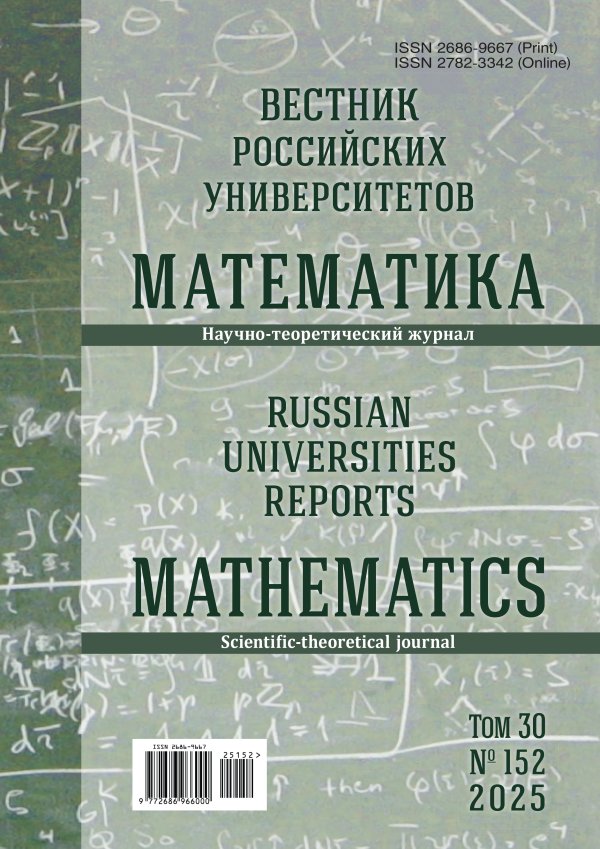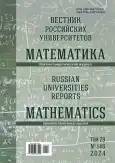Том 29, № 146 (2024)
Статьи
О гармоничности функции с условием типа Бохера–Кёбе
Аннотация
Пусть — открытый шар радиуса в с центром в нуле, и функция гармонична в Если имеет нулевой вычет в точке то поток ее градиента через любую сферу, лежащую в равен нулю. В данной работе изучается обратное явление для случая, когда допустимы лишь сферы одного или двух фиксированных радиусов и Найдено описание класса функций
где Доказано, что если не является отношением нулей функции Бесселя и то функция является гармонической в и Этот результат нельзя существенно усилить. А именно, если где или то существует негармоническая в функция такая, что
Кроме того, условие нельзя заменить, вообще говоря, требованием при произвольном фиксированном
 125-137
125-137


О рекуррентных движениях периодических процессов
Аннотация
Настоящая работа посвящена изучению свойств рекуррентных движений периодических процессов, заданных в хаусдорфовом секвенциально компактном топологическом пространстве .
Введено определение рекуррентного движения периодического процесса и установлено основное свойство движений, которое жестко связывает произвольные и рекуррентные движения. На основании этого свойства показано, что в случае автономного процесса, заданного в пространстве , классическое определение рекуррентного движения Дж. Биркгофа эквивалентно введенному в данной работе определению рекуррентного движения периодического процесса. Кроме того, показано, что в - и -предельные множества каждого движения автономного процесса являются секвенциально компактными минимальными множествами.
Основное значение полученных результатов состоит в том, что они фактически устанавливают взаимоотношение движений периодических процессов в пространстве .
 138-148
138-148


Глобализация сходимости кусочных ньютоновских методов
Аннотация
Рассматриваются варианты метода Ньютона для кусочно-гладких нелинейных уравнений, а также метода Гаусса–Ньютона для случая наличия дополнительных ограничений, снабженные процедурами одномерного поиска для невязки уравнения в целях глобализации сходимости. Кусочно-гладкие нелинейные уравнения с ограничениями естественным образом возникают как переформулировки систем уравнений и неравенств, включающих в себя условия комплементарности. В случаях, когда направление метода Ньютона не удается вычислить, или оно оказывается слишком длинным, алгоритм переключается на страховочные шаги градиентного метода для квадрата невязки уравнения с гладким кусочным отображением, активным в текущем приближении. Для метода Гаусса–Ньютона используются страховочные шаги метода проекции градиента. Получены результаты, характеризующие свойства возможных предельных точек последовательностей, генерируемых этими методами, а именно, стационарность всякой такой точки хотя бы для одного активного в ней гладкого кусочного отображения, а также условия асимптотической сверхлинейной скорости сходимости таких последовательностей. Особое внимание уделено требованию мажорирования нормы отображения нормами гладких кусочных отображений, играющему ключевую роль в анализе для кусочно-гладкого случая. Приведены примеры, демонстрирующие, что при невыполнении этого условия рассматриваемые алгоритмы могут генерировать последовательности, сходящиеся к точкам, не являющимся стационарными ни для одного активного гладкого кусочного отображения.
 149-163
149-163


О приближенном решении некорректно поставленной смешанной краевой задачи для уравнения Лапласа в цилиндрической области с однородными условиями второго рода на боковой поверхности цилиндра
Аннотация
Рассматривается смешанная по краевым условиям задача для уравнения Лапласа в области, представляющая собой часть цилиндра прямоугольного сечения c однородными краевыми условиями второго рода на боковой поверхности цилиндра. Цилиндрическая область с одной стороны ограничена поверхностью общего вида, на которой заданы условия Коши, т. е. заданы функция и ее нормальная производная, а другая граница цилиндрической области свободна. В этом случае задача обладает свойством неустойчивости задачи Коши для уравнения Лапласа по отношению к погрешности в данных Коши, т. е. некорректно поставлена, и ее приближенное решение, устойчивое к погрешности в данных Коши, требует применения методов регуляризации. Рассматриваемая задача сведена к интегральному уравнению Фредгольма первого рода. На основе решения интегрального уравнения, полученного в виде ряда Фурье по собственным функциям второй краевой задачи для уравнения Лапласа в прямоугольнике, построено явное представление точного решения поставленной задачи. Устойчивое приближенное решение интегрального уравнения построено методом регуляризации Тихонова. В качестве приближенного решения интегрального уравнения рассматривается экстремаль функционала Тихонова. На основе приближенного решения интегрального уравнения строится приближенное решение краевой задачи в целом. Доказана теорема сходимости приближенного решения поставленной задачи к точному при стремлении к нулю погрешности в данных Коши и при согласовании параметра регуляризации с погрешностью в данных.
 164-175
164-175


Сравнение спектров показателей блуждаемости нелинейной двумерной системы и системы первого приближения
Аннотация
В настоящей работе изучаются различные разновидности показателей блуждаемости решений линейной однородной и нелинейной двумерных дифференциальных систем с непрерывными на положительной полуоси коэффициентами. При этом все непродолжаемые решения рассматриваемой нелинейной системы определены на всей положительной полуоси времени.
В 2010 году И. Н. Сергеевым были определены скорость блуждания и показатели блуждаемости (верхние и нижние, сильные и слабые) ненулевого решения линейной системы. Скорость блуждания решения — это средняя по времени скорость, с которой движется центральная проекция решения на единичную сферу. А сильные и слабые показатели блуждаемости — это скорость блуждания решения, но минимизированная по всем системам координат, причем в случае слабого показателя блуждаемости минимизация производится в каждый момент времени. Следовательно, сильные и слабые показатели блуждаемости учитывают только ту информацию о решении, которая не гасится линейными преобразованиями: так, они учитывают обороты вектора вокруг нуля, но не учитывают его локальное вращение вокруг какого-либо другого вектора.
В данной работе проведено исследование по первому приближению сильных и слабых показателей блуждаемости. Установлено отсутствие непосредственной взаимосвязи между мощностями спектров (т. е. множеств различных значений на ненулевых решениях) сильных и слабых показателей блуждаемости нелинейной системы и системы ее первого приближения. А именно, построена двумерная нелинейная система, спектры сильных и слабых показателей блуждаемости сужения которой на любую открытую окрестность нуля фазовой плоскости состоят из всех рациональных чисел отрезка а спектры линейной системы ее первого приближения — только из одного элемента.
 176-187
176-187


Математическое моделирование физических процессов в композиционных средах
Аннотация
Рассматривается достаточно часто встречающаяся в промышленной сфере сплошная среда, состоящая из совокупности слоев (фаз) — слоистой однонаправленной композиционной среды (композитов), и физические процессы в слоях — процессы переноса, волновые процессы и изменение напряженно-деформированного состояния этой среды. Осуществляется математическое описание структуры композиционной среды в терминах слоистой области, формируется соболевское пространство функций с носителем в слоистой области (вместе со вспомогательными пространствами) для описания количественных характеристик слоев и устанавливается слабая разрешимость соответствующих краевых задач. При этом в местах взаимного примыкания слоев определены условия, описывающие закономерности процесса переноса и волнового процесса, а также изменения напряженно-деформированного состояния и перемещения точек слоев. Работа состоит из трех частей. Первая часть содержит описание структуры композиционной среды, основные понятия и описание классических пространств функций с носителем в слоистой области. Вторая часть посвящена построению вспомогательных пространств для математического описания краевых задач процессов переноса и волнового процесса, получению достаточных условий их разрешимости. Третья часть содержит описание упругих свойств композиционной среды, формируется задача о напряженно-деформированном состоянии среды, для которой строится пространство допустимых решений, удовлетворяющих соотношениям, описывающим законы перемещения точек в местах примыкания слоев, устанавливаются условия слабой разрешимости указанной задачи. Результаты работы используются при анализе задач оптимизации физических процессов и явлений в композиционных материалах.
 188-203
188-203


Альфа-множества и их оболочки: аналитические взаимосвязи в плоском случае
Аннотация
Рассмотрен класс замкнутых множеств двумерного евклидова пространства, в общем случае не являющихся чебышевскими множествами. Множества изучены с позиций двух известных определений, обобщающих классическое определение выпуклого множества. В рамках этих определений установлены аналитические взаимосвязи между параметрами, характеризующими невыпуклые множества. Найдены формула вычисления функции, определяющей степень невыпуклости замкнутого множества, и формула вычисления радиуса опорного шара. Указаны области приложения изучаемых конструкций в теории управления динамическими системами. Приведен иллюстрирующий пример, в котором предъявлена процедура аналитического вычисления чебышевского слоя невыпуклого множества с разрывной кривизной его границы.
 204-217
204-217


Методы построения инвариантных кубатурных формул для интегралов по поверхности тора в R3
Аннотация
В статье рассматривается вопрос о построении кубатурных формул для поверхности тора в инвариантных относительно группы порожденной отражениями в себя. У известных на данный момент инвариантных кубатурных формул, имеющих степень точности больше 3, число узлов существенно превосходит минимально возможное. В статье построены инвариантные кубатурные формулы степени 5 и 7 для поверхности тора с числом узлов, приближенному к минимальному. Приведены таблицы значений узлов и коэффициентов построенных кубатурных формул. Исследована зависимость этих значений от отношения радиусов направляющей и образующей окружностей тора. Для построения использовался метод инвариантных кубатурных формул, основанный на теореме С. Л. Соболева.
 218-228
218-228










